

Interesting facts. Freshwater Biome Facts. Freshwater Biome. A freshwater biome is one that many people overlook the importance of.
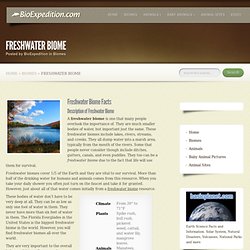
They are much smaller bodies of water, but important just the same. These freshwater biomes include lakes, rivers, streams, and creeks. They all dump water into a marsh area, typically from the mouth of the rivers. Some that people never consider though include ditches, gutters, canals, and even puddles. They too can be a freshwater biome due to the fact that life will use them for survival. Freshwater biomes cover 1/5 of the Earth and they are vital to our survival. These bodies of water don’t have to be very deep at all. They are very important to the overall balance of things. The freshwater biome is a location where there is plenty of nutrition and minerals. They vary in size significantly which can make giving characteristics of them difficult. Interesting. Freswater around the world. 11 largest freshwater fish in the world. Interested in uplifting stories on the natural world, sustainable communities, simple food, and new thinking on how to live well?

Please enter a valid email address and try again! No thanks. Climate. KDE Santa Barbara. Location | Plants | Animals | People | Links.
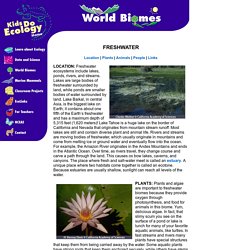
Climate - Freshwater Biomes. The freshwater biome covers only 0.8% of the total water on this Earth, yet the water which makes up this biome are distributed unevenly throughout the globe (W2).
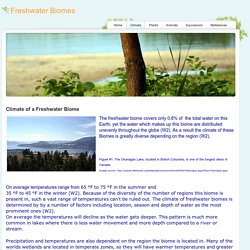
As a result the climate of these Biomes is greatly diverse depending on the region (W2). Figure #1: The Okanagan Lake, located in British Columbia, is one of the longest lakes in Canada. (Image source: On average temperatures range from 65 °F to 75 °F in the summer and 35 °F to 45 °F in the winter (W2). 37. 3.5.1 How will climate change affect the balance of water demand and water availability? - AR4 WGII Chapter 3: Fresh Water Resources and their Management. To evaluate how climate change will affect the balance between water demand and water availability, it is necessary to consider the entire suite of socially valued water uses and how the allocation of water across those uses is likely to change.

Water is valuable not only for domestic uses, but also for its role in supporting aquatic ecosystems and environmental amenities, including recreational opportunities, and as a factor of production in irrigated agriculture, hydropower production, and other industrial uses (Young, 2005). The social costs or benefits of any change in water availability would depend on how the change affects each of these potentially competing human water demands. Climate, weather, temperatures - City : FRESHWATER-CREEK.
Plants. Freshwater Plants - Kenilworth Park & Aquatic Gardens. Scirpus. Cattail. Native Freshwater Plants - Watershield - Brassenia. Ecology home > Water Quality >Aquatic Plants, Algae & Lakes > Native Freshwater Plants - Water Shield Water shield, also known as dollar pad or water target, is a native plant found in Washington's lakes and ponds.
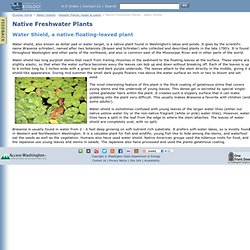
It goes by the scientific name Brasenia schreberi, named after two botanists (Brasen and Schreber) who collected and described plants in the late 1700's. It is found throughout Washington and other parts of the northwest, and also is common east of the Mississippi River and in other parts of the world. Water shield has long purplish stems that reach from trailing rhizomes in the sediment to the floating leaves at the surface. These stems are slightly elastic, so that when the water surface becomes wavy the leaves can bob up and down without breaking off. The most interesting feature of this plant is the thick coating of gelatinous slime that covers young stems and the underside of young leaves.
Copyright © Washington State Department of Ecology. Freshwater plants. Animals. Freshwater Dolphin. Freshwater shark. True freshwater sharks are sharks able to live in freshwater lakes and rivers, including: the bull shark, Carcharhinus leucas, which swims up tropical rivers around the worldthe river sharks, Glyphis, found in fresh and brackish water in Asia and Australiathe Mully Catfish A number of freshwater cyprinids (which are bony fish and thus quite unrelated to sharks) are also commonly called "freshwater sharks", "sharkminnows" or simply "sharks", particularly in the aquarium fish trade: Balantiocheilos melanopterus – Bala Shark, Tricolor Shark, Silver SharkEpalzeorhynchos – typical freshwater "sharks"Labeo – labeosPuntius denisonii – Roseline Shark.
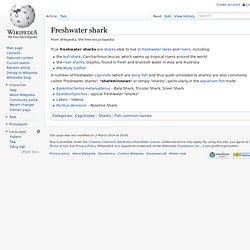
The 13 Scariest Freshwater Animals in the World. Photograph by Martin Shields, Alamy Notorious for their sharp teeth and voracious appetites, piranhas inhabit several of the major river basins in South America.

These omnivorous fish are known for their taste for meat, although attacks on human beings are quite rare, despite breathless accounts from early explorers. In a historic visit to Brazil, Theodore Roosevelt famously saw a group of piranhas shredding pieces of a cow carcass in seconds. His dramatic account would color popular imagination for years, even though it was based on a manipulated spectacle in which fishermen blocked off a group of the fish and starved them beforehand. Still, piranhas are important scavengers and predators in their native rivers, and they often resort to cannibalism if food gets scarce. It's unknown how many species of piranhas exist, with estimates ranging from 30 to 60.
Freshwater Animals (click on) Channel Catfish.